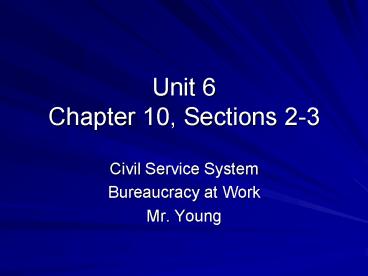Unit 6 Chapter 10, Sections 2-3 - PowerPoint PPT Presentation
1 / 14
Title:
Unit 6 Chapter 10, Sections 2-3
Description:
Unit 6 Chapter 10, Sections 2-3 Civil Service System Bureaucracy at Work Mr. Young Video http://www.youtube.com/watch?v=KSWSKXCFLe4&feature=fvwrel Dilbert: Management ... – PowerPoint PPT presentation
Number of Views:58
Avg rating:3.0/5.0
Title: Unit 6 Chapter 10, Sections 2-3
1
Unit 6Chapter 10, Sections 2-3
- Civil Service System
- Bureaucracy at Work
- Mr. Young
2
Video
- http//www.youtube.com/watch?vKSWSKXCFLe4feature
fvwrel - Dilbert Management Book
3
Section 2 Essential Question
- What are the similarities/differe-nces between
the Civil Service System and the Spoils System?
4
Spoils System
- Victorious politicians rewarding their followers
with government jobs - To the victor goes the spoils.
- Needed to rotate people in office, could cause
tyranny if in office too long - Inefficiency and corruption grew
- Needed experts in key positions, but were filled
with family or friends instead
5
(No Transcript)
6
Civil Service System
- Practice of Government employment on the basis of
open, competitive examination and merit - Created when Congress passed the Pendleton Act in
1883 - Have helped increase competition and allowed
qualified people to be in charge - Impossible to fire someone, easier to promote
them to something different
7
(No Transcript)
8
Similarities in the two
- People are given special preference (veterans)
(family and supporters) - Incompetent people in both scenarios
- When it comes to hiring/firing people, go from
one extreme to the next
9
Section 3 Essential Question
- How do you think that the Iron Triangle affects
the way Congress functions as a corporate body?
10
Bureaucracy at Work
- Public Policy- whatever action the government
decides to take (or not to take) - In theory, bureaucrats only carry out policy
decisions - In practice, bureaucrats help make policies
11
5 ways they influence policies
- Issue rules and regulations that put law into
motion - More than 50,000 pages of agency regulations are
filed a year - Draft new bills for Congress, testify about
legislation, provide lawmakers with technical
info
- 4. Decide disputes over application of laws or a
set of rules (act like courts) - 5. Provide advice to top political decisions
12
5 reasons why Bureaucracy makes Policies
- As the nation grows, government needs to grow to
meet its needs - As international crisis emerge, so does the
bureaucracy (Homeland Security) - As the economy gets worse, some believe the FG is
responsible to help those that are less fortunate
- 4. Citizen demand through client groups
(individuals or groups who work with the agency
and are most affected by its decisions) - 5. Federal Bureaucracies almost never die once
they are created for a specific need
13
Iron Triangle
- A small and informal but relatively stable group
of government agencies, congressional committees,
and interest groups who seek to promote policies
beneficial to a particular interest
- For Example
- Department of Veteran Affairs (bureaucrats)
- Veterans affairs committee in Congress
(legislators) - Veterans groups such as American Legion
(lobbyists/interest groups)
14
Iron Triangle
When these groups work together to make public
policy.
Program administration

























![Chapter 18: Cold War Conflicts [1945-1991] PowerPoint PPT Presentation](https://s3.amazonaws.com/images.powershow.com/7237467.th0.jpg?_=20151008125)





